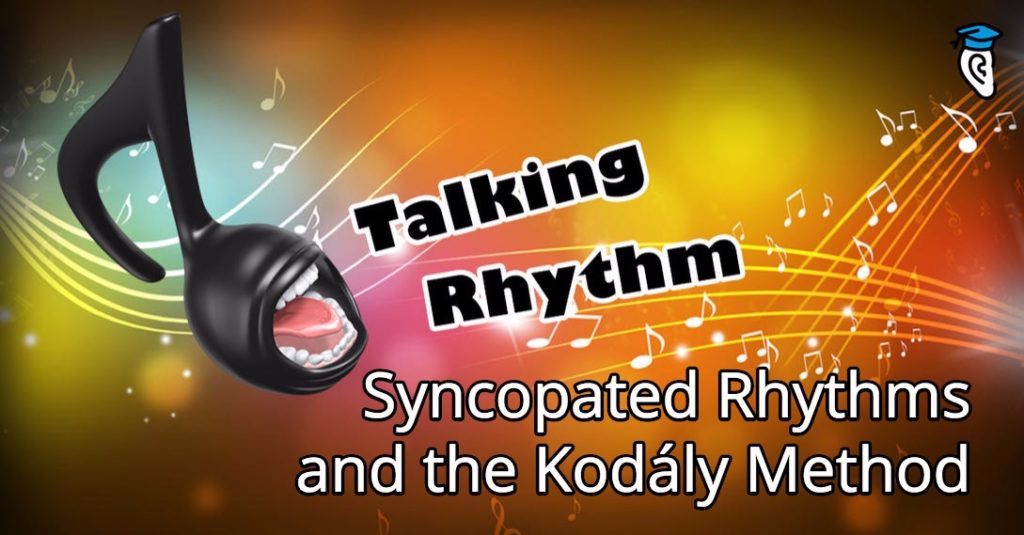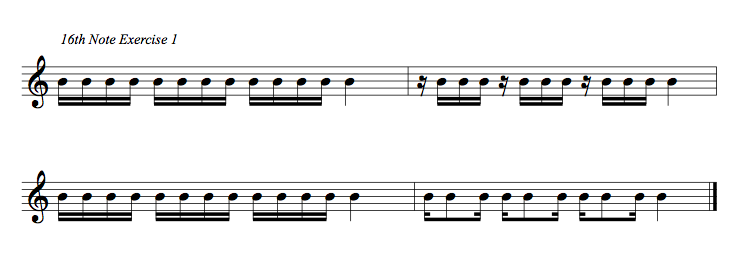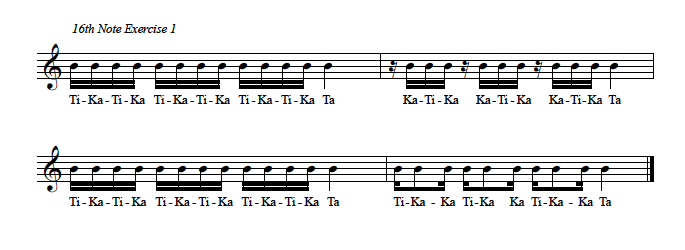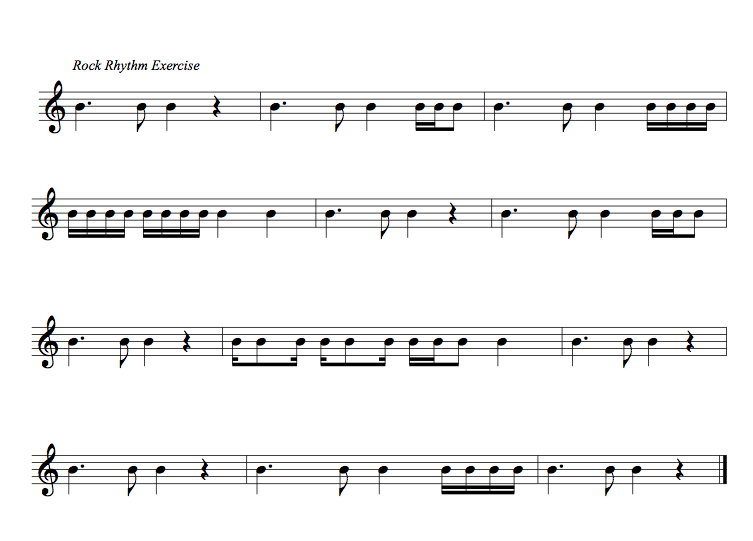Have you ever seen a syncopated beat like the one below and wondered if you were looking at cryptic ancient symbols? Do you wish you could read music better, or that there was a simple method to read notation?

Fortunately you can use the Kodály Method to read complex rhythms quickly. First designed as a means of teaching young children music skills in a fun way, the Kodály Method continues to help musicians at all levels develop their ear training skills. In the last article Talking Rhythm: The Kodály Method you learned how to count simple rhythms with quarter notes, 8th notes, and 16th notes. Now you will practice more complex syncopated rhythms using the Kodály Method.
Here’s our syllable chart again for reference:
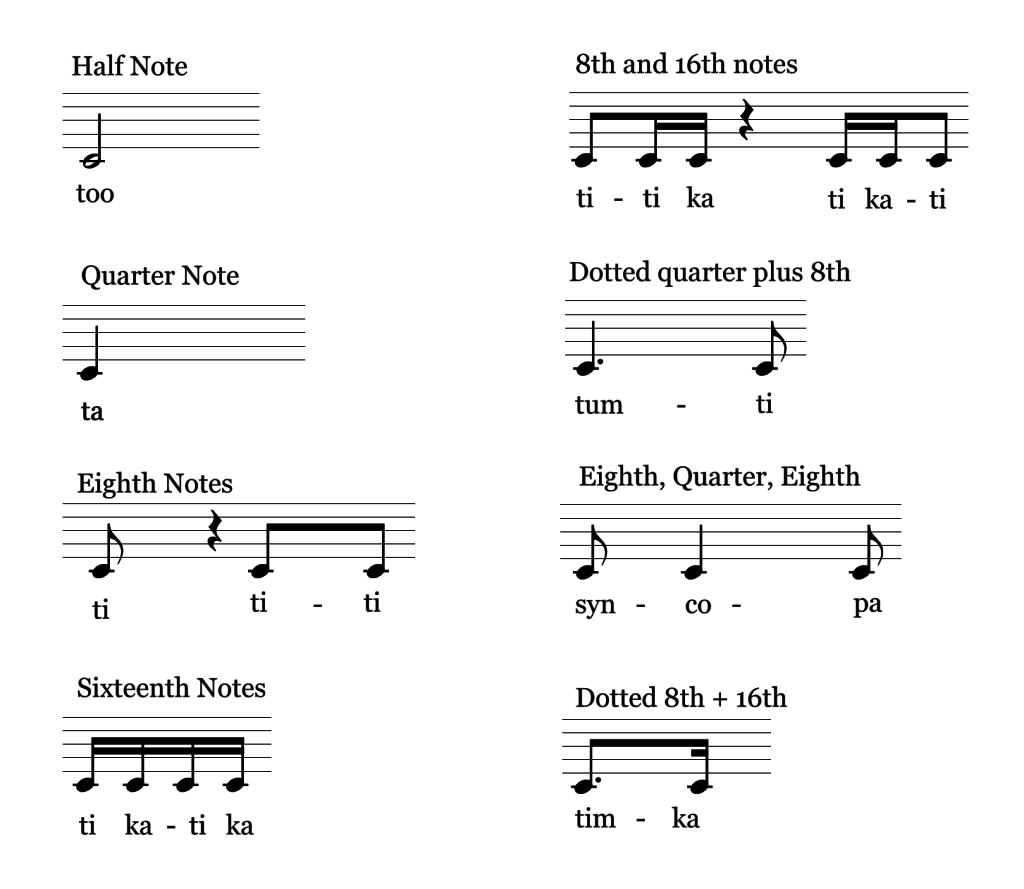
Let’s return to the notation example above. While the rhythm may seem very complicated at first, by breaking up the different notes and applying Kodály rhythm syllables, translating the rhythm becomes easier.

Now that we have written in the syncopated rhythm names, we can practice counting this rhythm out loud. Listen to the audio example a few times. Familiarize yourself with the syllables for each note. Try to count along with the audio clip.
Exercise 1: Syncopation and 16th notes
In this example you will practice transitioning from a simple 16th note rhythm to a more complex syncopated rhythm using the Kodály Method. You may need to listen to the example several times. Remember that it is better to practice at your own pace than to fly through these exercises and that continued practice will yield the best results.
This exercise uses a modified version of “chunking” which means taking a longer rhythm and breaking it up into its separate components. This is a very common way of learning new skills from music to language art skills and mathematics. By breaking a longer exercise into its smaller parts and learning the smaller parts first, the longer exercise becomes less daunting. We’ll begin with a simple 16th note rhythm and then move to a syncopated rhythm like the one we looked at above.
 Go through the rhythm and try to label the notes with the correct Kodály syllables
Go through the rhythm and try to label the notes with the correct Kodály syllables- Try speaking the rhythm
- If you can, tap your foot along with the beat at the same time
- Check your spoken rhythm against the label example below. Did you get it right?
- Play the audio sample several times
- Practice tapping the beat along with the audio sample
- Practing counting out the rhythm without the audio sample
How did you do on this exercise? If you need more time to learn these rhythms, take the time to practice with a metronome at various tempos. Tap your foot as you play to internalize the pulse. Invite a friend to play the rhythms with you or jam out on your instrument or a set of drums as you count out loud.
Once you feel that you can transition from a 16th note rhythm comfortably to a syncopated rhythm like the example above, then move on to this next exercise.
Exercise 2: Get Syncopated!
In the last exercise you practiced going from 16th note rhythms to syncopated rhythms. In this example you will read through a short syncopated rhythm using the Kodály Method.

Before you look at and listen to the labelled version below, try talking this rhythm yourself. Then listen and check if you had the timing right.

Compare Exercises 1 and 2. Do you recognize any of the rhythms in common? Use what you have learned so far of the Kodály Method to understand which syllables are used for each of these rhythmic patterns.
Exercise 3: Rock Rhythm
In this example you will use the Kodály Method to read through a rock rhythm that uses a combination of simple rhythms and syncopation. You will probably recognize many of these rhythms from popular music.
This kind of rhythm is very common for the bass player, pianist, or drummer in a band. Other instruments like the low brass or string bass in an orchestra may also play rhythms like this.
Use your audiation skills and knowledge of the Kodály method to work out the right syllables and imagine the rhythms in your head. Then talk it out loud. Finally listen to the audio clip and see how your performances matched up.
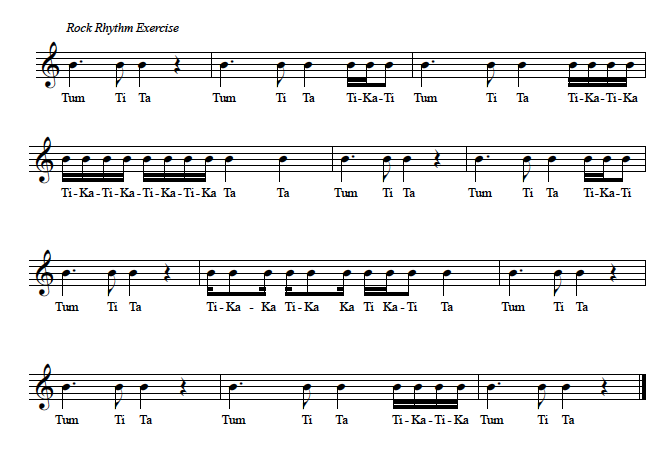
More Practice
Feel like you have started to master rhythm notation? Continue practicing these exercises as part of your everyday music routine. Here are some more exercises you can use to help you learn:
- Take a favorite nursery rhyme and practice “singing” the rhythms using the Kodály rhythm names.
- Print out popular sheet music and write the Kodály symbols under the rhythm. Practice the rhythm out loud.
- Take turns practicing syncopated rhythms with a friend.
- Notate a short rhythm and practice counting it out with syllables.
- Listen to a favorite song on the radio and try to figure out the rhythm using Kodály.
There are many musical resources that will help you develop your musicianship skills using the Kodály Method. Just a few of these sources are listed below:
- International Kodály Website
- Organization of American Kodály Educators
- About Education (Estrella, E.)
- British Kodály Academy
- Kodály Music Education Institute of Australia
Memorise the Kodály syllables and practice using them on rhythm examples like the ones above and you are well on your way to gaining a powerful tool for understanding rhythm notation and improving your natural sense of rhythm. Use these talking rhythm syllables for all the music you play and hear and you will quickly become a rhythm pro!

